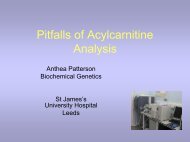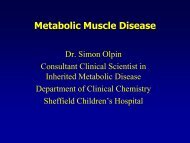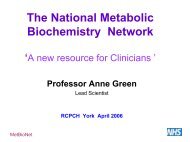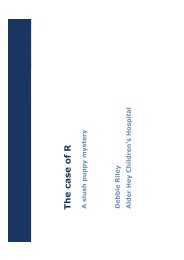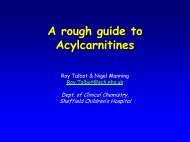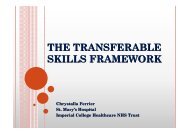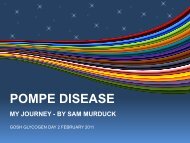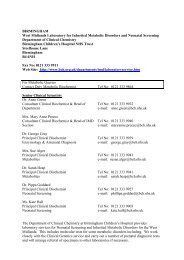Download Presentation - MetBio.Net
Download Presentation - MetBio.Net
Download Presentation - MetBio.Net
You also want an ePaper? Increase the reach of your titles
YUMPU automatically turns print PDFs into web optimized ePapers that Google loves.
Acylcarnitines And InheritedMetabolic DiseaseDavid Hardy
Overview• Free Carnitine and Acylcarnitines– Role in fatty acid oxidation– Appearance in disease• Measurement by tandem MS• Examples of use in diagnosis
CarnitineCOO -HO• Essential component of fatty acidCH 2oxidationC HCH 2+ NMe 3• Deficiency leads to impaired longchain fatty acids
Glucose, Fats and Energy• Glucose is a primary fuel– Glycogen reserves are exhausted in 24 – 48 h– Additional glucose comes from gluconeogenesis• Occurs concurrently with glycogenolysis, but also on its own when glycogenexhausted• Gluconeogenesis from pyruvate (via oxaloacetate) provides glucose toorgans that cannot use other fuels• Fatty acid oxidation provides alternative source of ATP, andfuel (ketones) to some other organs– Fatty acids are better fuels than amino acids and carbohydrates,• 1 g fat generates 37.7 kJ• 1 g carbohydrate generates 16.7 kJ– Energy may be used directly (heat) or stored chemically– Also promotes gluconeogenesis
Catabolism: A Bird’s-eye ViewProteinsGlycogen & starchTriacylglycerolsAmino acidsGlucoseFatty acidsATPPyruvateCO 2NH 4+Acetyl-CoAOxaloacetateTCA cycleGTPCO 2Acetyl CoA common intermediate – feedsinto TCA to complete oxidation processAbundance of acetyl-CoA stimulatesgluconeogenesisNADHQH 2Energy produced by catabolism stored asATPO 2ATP, GTP, NADH, QH 2H 2 OAfter Horton et al. Principles of Biochemistry 3e
Mitochondrial Fatty Acid Oxidation• Mitochondrial fatty acid oxidation requires:– Carnitine shuttle• Active transport mechanism• Facilitates entry of long chain fatty acids acyl CoAspecies into mitochondrion• Not required for medium/short chain species ( < C12) -free passage– b-oxidation spiral• For acids with 20 or less carbons• Series of reactions that sequentially shorten the carbonskeleton• Generate acetyl-CoA as end product
The Carnitine CycleFree carnitineFatty acidsCARNITINETRANSPORTERPlasmamembraneCoASHACYL-CoASYNTHASECPT-2TRANSLOCASE CPT-1Acyl CoACarnitineAcylcarnitineOuter mitochondrialmembraneInner mitochodrialmembraneCoASHCarnitineAcylcarnitineAcyl CoA
-Oxidation SpiralORSCoAFADOSCoAOAcyl CoADehydrogenaseFADH 2HSCoARSCoAetcThiolaseOOORSCoARSCoANADHL-3-Hydroxy-acyl CoAdehydrogenaseOHOEnoyl-CoAhydrataseH 2 ONADRSCoA
Acyl Carnitines in Fatty AcidOxidation & Organic Acid Disorders• Acyl carnitines are intermediates in normal long chain fattyacid oxidation.• A defect in long chain fatty acid oxidation might beexpected to lead to secondary acyl carnitine formation.• Acyl carnitines are formed from acyl CoA species; defectsin any other pathway involving acyl Co A species can leadto secondary accumulation of acyl carnitines– Fatty acid oxidation defects after the carnitine shuttle– Organic acidaemias
• Sample requirementsAnalytical Aspects– Dried blood spot (3mm disc punched)– Plasma/serum – 100µL (10 µL used)• Early literature suggested problems with EDTA, but LiHep,FlOx and EDTA OK in personal experience– Urine – 100µL (10 µL used)– Bile – 100µL (10 µL used)• Essentially the same for PKU screening assay
Blood spotsPlasma (and other fluids)Punch 3mm disk of blood spotinto microtitre plate or EppendorftubePipette 10 µL fluid into Eppendorf tubeAdd 200 µL internal standardAdd 200 µL internal standardCover and mix for 30'Cap, mix and centrifugeTransfer to polypropylene microtitre plateEvaporate to drynessAdd 100µL "3M" HCl in n-BuOHCover and heat @ 45 - 60°C for 20'Evaporate to drynessReconstitute with 80% MeCNAnalyse
MS/MS 1–Generic triple quadrupole tandem mass spectrometerDetectorIon source1 st Analyser (Q1)Collision Cell (q2)2ns Analyser (Q3)
MS/MS 2• Parents of m/z 85 – acyl carnitines as butyl estersOOOCollision Induced DissociationH 2 C +OOHOBuMe 3 N + C 4 H 8Me 3 N RCO 2 H• First quadrupole scans m/z 215 – 550• Second quadrupole – gas cell – collision induceddissociation• Third quadrupole static at m/z 85
MS/MS 3• Allows quantitation of plasma free carnitine• Allows identification of disease-specific patterns• Quick and easy – “stat” results in ca. 1h• Butylation methods result in slight hydrolysis effect– Free carnitine slightly higher than true value (few µM)• Detects anything that gives a m/z 85 fragment– NOT specific for acyl carnitines, but good enough mostof the time
Normal Acylcarnitine Pattern16Apr003IMD020 1 (1.108) Sm (SG, 2x0.75); Sb (33,10.00 )221.51001: Parents of 85ES+2.17e6375.5263.5403.8C0-d 3C3-d 3C10-d 3C12-d 3C14-d 3C16-d 3C2-d 3431.8C0260.7C2459.5459.9260.3%277.3C18:1C8-d 3C16347.7C18456.8C8484.6482.6485.1228.0246.4274.7302.3291.9318.5342.8401.8428.9438.0473.1501.30220 240 260 280 300 320 340 360 380 400 420 440 460 480 500 520 540m/z
Acylcarnitines in Health• C0 – free carnitine• C2 – acetyl carnitine• C3 – propionyl carnitine – small amount• C4 – butyryl carnitine – small amount• C8 – octanoyl carnitine – trace• C16 – palmitoyl carnitine• C18:2 – linoleyl carnitine• C18:1 – oleyl carnitine• C18:0 – stearoyl carnitine
Why Numbers?• Acylcarnitines are referred to by the number ofcarbon atoms present in the acyl group• Structural isomers exist for several acyl groups– These have the same m/z ratio– Definitive identification is not possible from simpleparents of 85 experiment– Using C numbers overcomes this• Some acylcarnitines are derived from hydroxylatedacyl groups and are denoted, e.g. C5-OH• Those from dicarboxylic acyl groups are denoted,e.g. C5-DC• Unsaturated species are denoted, e.g. C16:1
Diagnostic Uses• In principle can detect any disorder resulting in theaccumulation of acyl-CoA species.• In practice, about 24 conditions can be detected– PA, MMA & B12 deficiency, malonic aciduria, 3-methylcrotonyl-CoA carboxylase deficiency, IVA, GA-1,biotinidase deficiency, holocarboxylase synthasedeficiency, 2-methyl-3-hydroxybutyryl CoAdehydrogenase deficiency, isobutyryl-CoAdehydrogenase deficiency, b-ketothiolase deficiency,HMG-CoA lyase deficiency, carnitine transporterdeficiency, CPT-1, translocase, CPT-2, VLCADD,TFP/LCHADD, MCADD, SCADD, SCHADD, MADD
CPT-I Deficiency 1• Blocked formation of long chain acyl carnitines fromacyl-CoA esters– Long chain acyl-CoA species accumulate – toxic!– Other pathways metabolise them (peroxisomes) to mediumchain species which are free to enter b-oxidation• <strong>Presentation</strong> – largely hepatic– Coma, seizures, hepatomegaly, hypoketotichypoglycaemia (often set off by fasting)– Some cases have increased CK(MM) – not all– No chronic muscle weakness or cardiomyopathy
CPT-1 Deficiency 2• Deficiency means long chain acyl carnitines are notsynthesised• High free carnitine and virtually undetectable longchainacyl carnitines is diagnostic pattern
CPT-II Deficiency• Defect in regenerating acyl-CoA from acyl carnitine• Consequences– Toxic long chain acyl carnitines accumulate• <strong>Presentation</strong>– Classical muscular form• Adult presentation, myoglobinuria and muscle weakness onexercise• CK may be normal between attacks– Neonatal (severe/fatal) form – more hepatic• Coma, hypoketotic hypoglycaemia• Hepatomegaly, cardiomegaly, cardiac arrythmias
Propionic & Methylmalonic Acidurias 1• Clinical findings– Moderate hepatomegaly– Acidosis, ketosis– Hyperammonaemia (may be confused with urea cycledefect if NH 3 > 800 µM)– Hypocalcaemia and hyperlactic acidaemia common– Glucose may be low, normal, high– Neurological complications due to basal ganglia necrosis– Renal damage, possibly leading to renal failure in MMA
Isovaleric AciduriaIM D 252 1 (1.021) S m (S G , 2x0.75); S b (33,10.00 ) 1: P arents of 85E S +221.21001.13e6218.3302.4%260.2261.3263.2459.5243.2288.2316.4347.2456.7356.3 482.60200 220 240 260 280 300 320 340 360 380 400 420 440 460 480 500 520 540m /z
• Clinical FeatureGlutaric Aciduria Type 1– Macrocephalic at birth, preceding severe neurological crisis– Hypotonia, head-lag, irritability and jitteriness– Feeding problems– First febrile illness, or immunisation, leads to increased (butreversible) hypotonia– Neuroimaging reveals fronto-temporal atrophy and delayedmyelination– Subdural haemorrhaging common when starting to walk– Illness and fasting may precipitate neurological crises– Brain damage results in loss of motor and posture, but intelligenceis preserved – damage not reversible at this stage
Glutaric Aciduria Type 1Tryptophanseveral stepsHydroxylysinePhosphohydroxylysineLysine2-Aminoadipic-4-semialdehydesynthaseSaccharopine2-Aminoadipic-4-semialdehydesynthase2-Aminoadipic-4-semialdehyde2-Aminomuconic acid2-Aminoadipic acid2-Aminoadipate aminotransferase/2-oxoadipate dehydrogenaseGLUTARIC ACIDURIA2-Oxoadipic acid2-Aminoadipate aminotransferase/2-oxoadipate dehydrogenaseGlutaryl-CoAGlutaconyl-CoAGlutaryl-CoA dehydrogenase/glutaconyl-CoA dehydrogenaseGlutaryl-CoA dehydrogenase/glutaconyl-CoA dehydrogenase
Glutaric Aciduria Type 115FebIMD007 1 (1.117) Sm (SG, 2x0.75); Sb (33,10.00 )218.31001: Parents of 85ES+1.92e6388.5260.4%263.4459.5221.3274.3 347.3332.4288.3482.70200 220 240 260 280 300 320 340 360 380 400 420 440 460 480 500 520 540m/z
Worked Example 130Jan003IMD025 1 (1.116) Sm (SG, 2x0.75); Sb (33,10.00 )218.61001: Parents of 85ES+3.07e6482.7456.8484.1%260.4375.4403.4431.6221.5263.7459.1480.5274.5277.6288.5347.5366.1400.2428.3427.0442.9454.5470.9510.30220 240 260 280 300 320 340 360 380 400 420 440 460 480 500 520 540m/z
Translocase Deficiency• Defect in transporting acyl carnitines across innermitochondrial membrane & antiporting free carnitine• <strong>Presentation</strong> – may be severe or mild– Hypoglycaemia, hyperammonaemia, muscle weakness– Cardiomyopathy• Lab findings– C16:0, C18:1 and C18:2 acyl carnitines predominate– Low free carnitine (most converted to esters)– Short chain species may be seen (esp. in urine) showingperoxisomal oxidation still occurs• Diagnosis by fibroblast enzyme activity
Worked Example 2010202-15201Feb02-176 1 (1.109) Sm (SG, 2x1.00); Sb (33,10.00 )100260.51: Parents of 85ES+1.60e6%0456.6218.4221.4482.7263.3459.7484.5277.5500.6472.5426.8454.6347.5498.7228.1400.5243.2 424.2444.5288.4 318.6372.4510.4 528.4220 240 260 280 300 320 340 360 380 400 420 440 460 480 500 520 540m/z
LCHADD 1• Defective metabolism of long chain 3-hydroxyacyl-CoA• Consequences– Build-up of long chain 3-hydroxyacyl-CoA species– Evidence of toxicity• Cardiotoxic• Other effects on metabolism• Replacement of long chain fats with medium chainspecies and carbohydrate rich feeds is means of Rx
• <strong>Presentation</strong>– Very heterogeneousLCHADD 2• Fulminant liver disease – liver disease may be very severe inLCHADD• Hypertrophic cardiomyopathy• Occasionally progressive neuropathy/ pigmenting retinopathy(neuropathy uncommon in other FAODs)– Most have fasting-induced hypoketotic hypoglycaemia– Some have cardiomegaly (LVH)– Some have muscle weakness – elevated CK andmyoglobinuria may be seen during attacks
Worked Example 303MAY02IMD020 1 (1.105) Sm (SG, 2x0.75); Sb (33,10.00 )100344.51: Parents of 85ES+2.75e6260.4%218.5221.4263.4277.5288.6316.4336.5347.4370.3372.6459.5456.5 470.50220 240 260 280 300 320 340 360 380 400 420 440 460 480 500 520 540m/z
Medium Chain Acyl-CoA DehydrogenaseDeficiency 1• Defective oxidation of C6 – C10 acyl CoA• Clinical– Commonest fatty acid oxidation defect but easily treated!– Ca. 1:15000 incidence in NW Europe– 25% of patients die at first episode– 25% remain unsymptomatic for life– Hypoketotic hypoglycaemia during acute attacks– Liver dysfunction– Lethargy/coma– Cardiomyopathy, respiratory arrest
• Lab findings– Organic acidsMCADD 2• Characteristic metabolites present during acute crises• Profile may be normal when well– Acyl carnitines• Profiles preserved in well-states• Molecular Biology– 80 - 90% of caucasian cases have G985A mutation– Several other mutations know• A799G, T157C, A447G, C730T, C1124T etc• Some are clinically silent, but not biochemically so– Incidence of MCADD may change when MS/MS screening routine
Worked Example 421Feb003IMD034 1 (1.107) Sm (SG, 2x0.75); Sb (33,10.00 )218.41001: Parents of 85ES+2.68e6426.5456.8%221.2228.9260.6263.3277.6375.6372.7347.6 400.9403.8424.8482.7484.3427.8454.6428.6480.8431.8 442.0 459.6468.5512.1509.80220 240 260 280 300 320 340 360 380 400 420 440 460 480 500 520 540m/z
VLCADD• Defect in metabolising C12 – C18 acyl CoAs• Consequences– Long chain species accumulate• Toxic and metabolised by peroxisomes and microsomes to limitbuild-up– Replacing long chain fats in diet by MCT affords Rx• <strong>Presentation</strong> – 3 forms– Neonatal – lethal with cardiomyopathy and hepaticinvolvement (hyperammonaemia, coma)– Childhood and adult – mostly muscular like adult CPT-IIwith myoglobinuria
• Variable presentationPost-Mortem Samples• Usually see increase in free and short chain acylcarnitines– May have more or less abnormalities– Useful for investigation of SUDI– Statistically, most cases reveal no biochemicalabnormalites other than PM changes– Some cases are clear cut (e.g. for MCADD)– Some cases are just uninterpretable
Typical Post-Mortem Profile2 M a y0 0 IM D 0 0 6 1 (1 .1 0 6 ) S m (S G , 2 x 0 .7 5 ); S b (3 3 ,1 0 .0 0 ) 1 : P a re nts o f 8 5 E S +2 6 0 .31 0 08 .6 3 e 62 1 8 .1%2 6 3 .32 2 1 .22 8 8 .33 0 4 .34 5 9 .63 4 7 .0 4 5 6 .34 8 2 .402 7 4 .02 2 0 2 4 0 2 6 0 2 8 0 3 0 0 3 2 0 3 4 0 3 6 0 3 8 0 4 0 0 4 2 0 4 4 0 4 6 0 4 8 0 5 0 0 5 2 0 5 4 0m /z
Diagnosis?302459260263347456
Wrong!
Why?• PAR 85 experiment not specific toacylcarnitines– acylcarnitines are detected because they form am/z 85 fragment– other species forming m/z 85 fragments willalso be detected– possible diagnostic problems if other specieshas same mass as an acylcarnitine
Isobaric Species• Compounds with the same m/z ratio, but notnecessarily the same chemical composition (cf.isomers)– Pivaloylcarnitine and isovalerylcarnitine– Valproylcarnitine and octanoylcarnitine
IsomersH 3 CH 2 C CH 2H 2 C CH 2H 3 C CH 2H 2 C CH 2CH 3H 2 C CH 2OH 2 CCHOOctanoyl carnitineCarnitineOCarnitineO2-Propylpentanoyl carnitine(valproyl carnitine)
Isomers & Isobars – On The Buses…
• Non-derivitisationOther Considerations– PAR 85 experiment, but m/z are 56 units less thancorresponding Bu esters– Ion counts lower – more ion suppression– Less sensitive for dicarboxylic species (e.g. in GA-1)• Paired blood spots and plasma specimens?– Generally plasma is more sensitive, but exceptions– Ideal to have both (e.g. from one whole blood spec)– Can use either, but if only one available better to justhave plasma
Summary• Acylcarnitine profiling is easy to implement withMS/MS.• Several diseases give diagnostic patterns, althoughin some cases definite diagnosis is not possible.• Acylcarnitines usefully complement organic andamino acid profiling in diagnosis of metabolic“small molecule” disease.


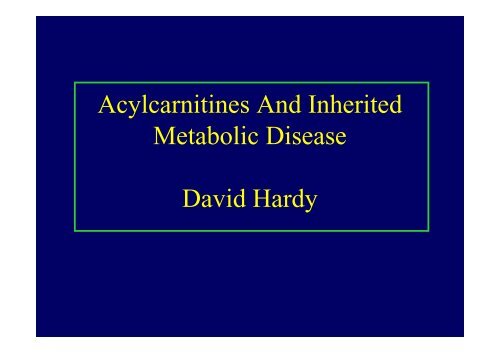
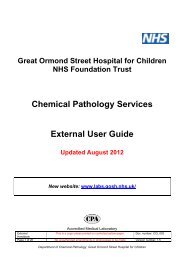
![GSD 14.10.10.ppt [Compatibility Mode] - MetBio.Net](https://img.yumpu.com/49674680/1/190x135/gsd-141010ppt-compatibility-mode-metbionet.jpg?quality=85)
